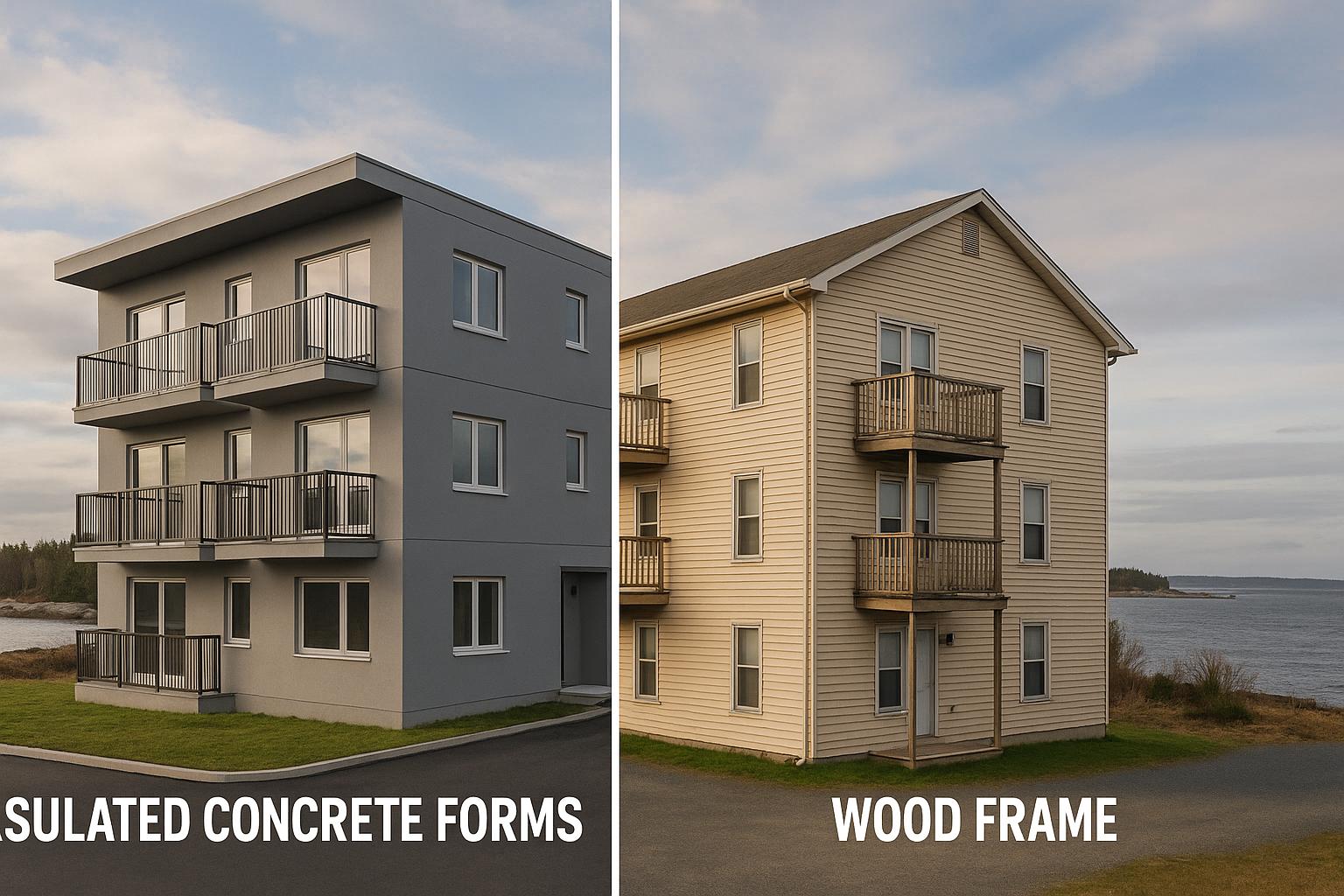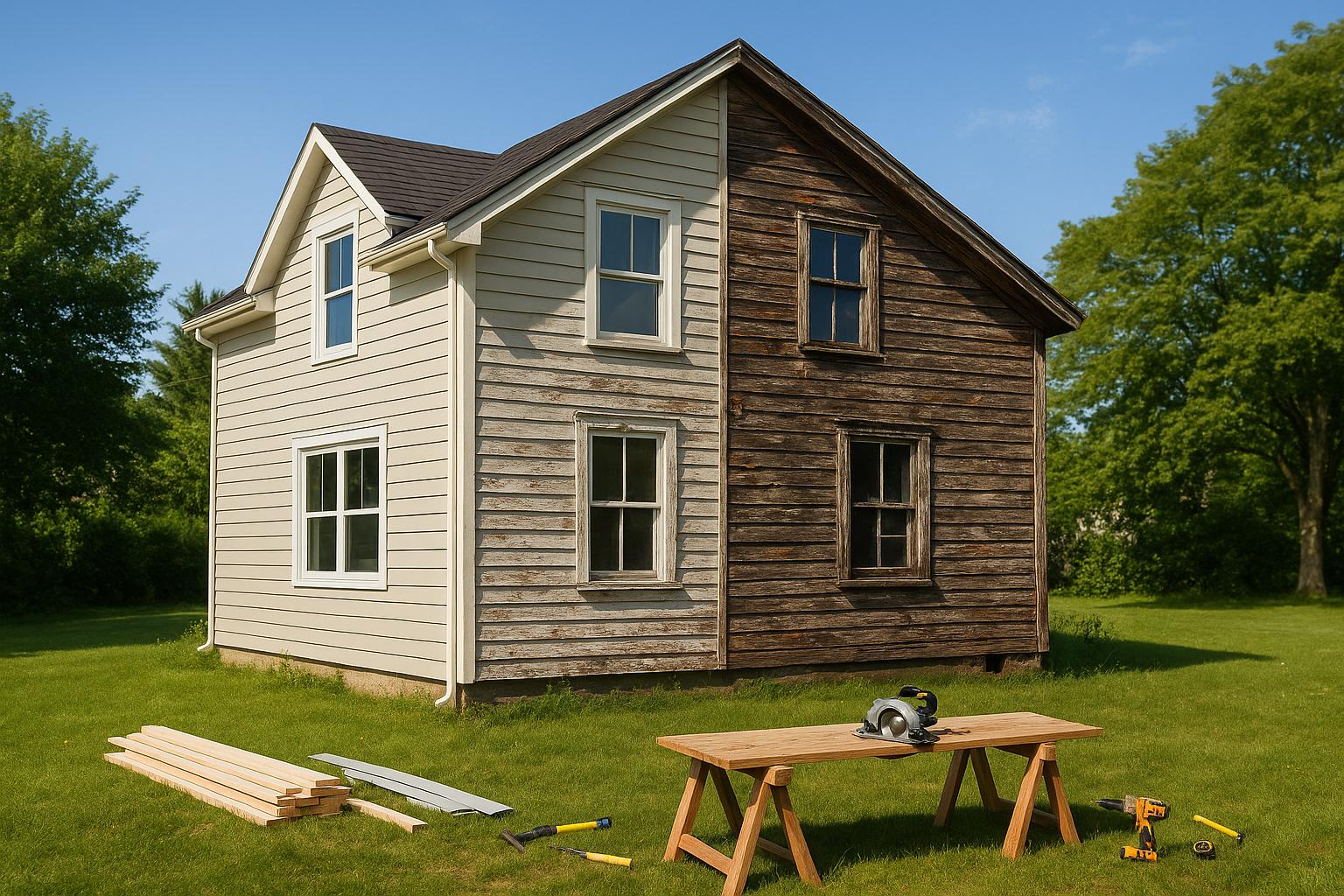Owning a heritage property in Nova Scotia means balancing personal renovations with preservation rules. Changes to these properties often require approval to ensure their historical value is maintained. Here’s what you need to know:
- Approval is mandatory for changes affecting the exterior, structure, or landscape, especially if they alter historical features.
- Designation matters: Properties can be provincially or municipally designated, each with its own rules.
- Heritage Conservation Districts have stricter guidelines for entire neighbourhoods.
- Key steps: Consult local heritage staff, prepare detailed documentation, and follow conservation principles to avoid issues.
Understanding and following these processes protects both your property’s historical importance and your investment. Early planning and expert advice are essential.
How Does Certificate Of Appropriateness Affect Renovations? - CountyOffice.org
What Is a Heritage Property and How Is It Designated?
A heritage property refers to a structure, streetscape, or landscape officially recognized under Nova Scotia's Heritage Property Act for its historical, architectural, and cultural value. The designation process evaluates properties based on these criteria, granting them legal protection and establishing a defined approval process for any alterations.
This classification directly impacts how you can modify your property.
Provincial vs Municipal Designations
Heritage properties in Nova Scotia can be designated at either the provincial or municipal level, with each level having its own approval authority and scope of significance. The designation level determines the approval process and identifies which authority oversees proposed changes.
- Provincial designation applies to properties with heritage value significant to Nova Scotia's broader history. The "Advisory Council on Heritage Property", created by the Governor in Council, makes recommendations to the Minister, who has the final say. Property owners can submit applications directly to the Advisory Council for consideration [4].
- Municipal designation focuses on properties representing the history of a specific community. Municipalities establish their own Heritage Advisory Committees, which recommend properties for designation. The municipal council makes the final decision [4]. Unlike provincial designations, municipal applications can be submitted by third parties without requiring the owner's consent, although the owner will be notified [4].
Both types of designation initiate a 120-day protection period during the evaluation process. During this time, property owners cannot make significant exterior alterations or demolish the property [4].
"Where each municipality may have its own registry, it is important to be aware of what by-law may apply to your property." – Cox & Palmer [4]
Provincial designations can include individual properties, streetscapes, public-building interiors, and cultural landscapes [5][2]. Municipal designations cover similar categories but also include heritage conservation districts, which are unique to the municipal level [5][2].
Heritage Conservation Districts
In addition to individual designations, some areas benefit from district-wide heritage rules. Heritage Conservation Districts apply consistent heritage standards across entire neighbourhoods, rather than focusing on individual properties. These districts are developed by the community and governed by specific by-laws [5].
If your property is located in a Heritage Conservation District, you'll need to follow the district's by-laws, which often regulate architectural styles, materials, colours, and other design features to preserve the area's historical character.
To determine if your property lies within a Heritage Conservation District, consult municipal resources. For example:
- Halifax Regional Municipality offers an interactive online map through HRM Open Data [6]. You can also contact the Heritage Property Program staff directly.
- The Municipality of the District of Lunenburg provides a "Heritage Properties Registry Index" in PDF format and accepts written requests for information through its Planning Department [7].
Cultural Landscapes and Their Impact
Cultural landscapes go beyond individual properties, encompassing broader areas with historical importance. These can include both Provincial Cultural Landscapes and Municipal Cultural Landscapes, each managed by their respective designation authorities [5][2].
Cultural landscapes might feature farming regions or former industrial sites. If your property is within such a landscape, modifications must consider not only the building itself but also the area's overall historical context.
To check if your property is part of a cultural landscape:
- Visit the Provincial Registry of Heritage Properties through the Nova Scotia Department of Communities, Culture and Heritage website [2][1].
- Use the Canadian Register of Historic Places, which lists sites designated under the Heritage Property Act [2][4].
For municipal cultural landscapes, contact your local municipal planning department or heritage staff, as each municipality may have its own registry and regulations [6][7].
Knowing whether your property falls under these designation categories is crucial for planning any changes. The type of designation will determine the approval process and specific requirements you must follow.
Changes That Require Approval for Heritage Properties
When it comes to heritage properties, certain modifications demand formal approval to ensure renovations align with preservation standards. Under the Heritage Property Act, any change that impacts a property's character-defining elements - like its architecture, materials, or design - is considered a "Substantial Alteration" and must undergo a formal review process[8].
Exterior Changes
Alterations to the exterior that influence the overall appearance of a heritage property require approval. Significant adjustments to the facade or other prominent external features can compromise the historical character of the property. Before proceeding with such changes, property owners should consult heritage authorities to determine if their plans qualify as Substantial Alterations[8]. This step is crucial for maintaining the property's historical integrity.
Structural Changes and Additions
Structural changes, such as expansions or major modifications, are also subject to approval under the Substantial Alterations guidelines. For properties located within Heritage Conservation Districts, obtaining a Certificate of Appropriateness may be necessary for additions, demolitions, or other exterior alterations. Larger projects might also require a Heritage Development Agreement to ensure compliance with preservation standards[8].
Demolition work that removes or alters elements contributing to the property's heritage value cannot proceed without approval. Even interior structural changes that affect character-defining elements must undergo formal review. These regulations are designed to safeguard the property's historical essence, whether the changes are inside or out.
All work must follow conservation principles like "Minimal Intervention", which focuses on achieving functional goals while minimizing the impact on heritage features. Property owners are expected to document every stage of the work with photos, drawings, and detailed descriptions, including specifics about materials used[3].
For guidance, property owners can reach out to heritage staff for free expert advice and on-site consultations to clarify approval requirements for their projects[8].
Landscape and Site Changes
Changes to the landscape or site can also require approval if they affect the property's historical setting or outdoor character. Modifications to driveways, walkways, gardens, fencing, or outbuildings may need a review, especially if they alter the property's heritage character or its connection to the surrounding environment.
For properties designated as cultural landscapes, additional considerations come into play. These sites must preserve not only individual features but also the broader historical context of the area. Heritage authorities can provide clarity on whether planned landscape changes require formal approval.
sbb-itb-16b8a48
How to Navigate the Approval Process
Securing approval for changes to a heritage property involves careful planning, thorough documentation, and open communication. Here’s a step-by-step guide to help you move through the process efficiently, from the initial consultation to meeting compliance requirements.
Initial Consultation and Documentation
Start by consulting with your local heritage authority to understand the permits and approvals needed for your project. Prepare a comprehensive set of documents, including site plans, architectural drawings, material specifications, and photographs. These materials should clearly demonstrate how your proposed changes will respect and preserve the historic character of the property.
Submission and Review Process
Once you’ve gathered all the necessary documentation, submit your application along with the supporting materials. During the review, your proposal will be evaluated against established conservation guidelines. Be prepared to address feedback or make adjustments if requested. Timely responses to revision requests can help keep the process on track.
Decision, Appeals, and Next Steps
If revisions are required, reach out to the heritage authority for clarification and guidance. When your application is approved, ensure you comply with all permit conditions. Stay in regular contact with heritage staff throughout the project to meet conservation standards and avoid any compliance issues down the line.
Key Regulations, Tools, and Resources for Compliance
Navigating heritage property regulations can feel overwhelming, but understanding the rules and using the right resources can save you time, money, and potential headaches - all while preserving your property's unique history.
Applicable Legislation and Guidelines
Before starting your project, it's essential to understand the legal and design standards that apply. In Nova Scotia, heritage regulations are primarily governed by municipal bylaws and design guidelines. These local documents outline specific requirements for alterations, materials, design, and maintenance to help maintain the historical integrity of properties.
On a national level, the Standards and Guidelines for the Conservation of Historic Places in Canada, produced by Parks Canada, serve as a comprehensive reference for heritage conservation. These guidelines, available online, offer practical advice for creating conservation plans and executing interventions. They're a go-to resource for ensuring your project aligns with best practices in heritage preservation.
Compliance Resources and Support
Your first stop for guidance should be your municipal Planning & Development department. These departments often have dedicated heritage staff, planners, and officers who provide free consultations and expert advice on managing and maintaining heritage properties. For instance, in the Halifax Regional Municipality, property owners can reach out to Jesse Morton at mortonj@halifax.ca or 902.717.38 for assistance with heritage-related questions.
Heritage Advisory Committees are also instrumental in the process. These committees review proposed changes to heritage properties and offer recommendations to municipal councils. If you're considering registering a heritage building or have questions about the review process, contact your local municipal government to connect with your committee.
For broader support, the Provincial Heritage Property Program Staff can provide guidance on conservation practices, manage grant programs, and assist with municipal heritage projects. Additionally, organizations like the Heritage Trust of Nova Scotia offer hands-on help, detailed guides, and registration information for heritage properties.
Many municipalities now provide online tools to simplify your research and application process. For example, Halifax offers an interactive Registry of Heritage Properties, while East Hants provides a Heritage Property Map. These tools allow you to explore registered heritage properties in your area. Municipal websites also typically host downloadable forms for heritage registration and alteration approvals, helping you prepare your documentation in advance.
Tips to Avoid Delays and Legal Issues
Here are some practical steps to keep your project on track and avoid unnecessary complications:
- Start with a consultation: Reach out to your municipal Planning & Development department early in your planning process.
- Seek professional advice: Connect with local heritage professionals for free consultations and on-site advice to ensure your plans align with conservation principles.
- Review national guidelines: Familiarize yourself with the Standards and Guidelines for the Conservation of Historic Places in Canada to ensure your designs meet expected standards.
- Leverage online tools: Use municipal resources to access bylaws, design guidelines, and application forms, so you're fully prepared before submitting your application.
- Document everything: Keep detailed records of your work and maintain open communication with heritage staff to avoid compliance issues and costly adjustments.
- Explore funding options: Investigate financial support programs, including provincial and municipal grants, to help offset the costs of preserving your property's historic value.
Conclusion: Preserving Heritage While Moving Forward
Owning a heritage property in Nova Scotia is about striking a balance - keeping history alive while meeting today’s needs. While the approval process might seem daunting, starting early and ensuring proper documentation can make it much smoother. This approach helps align modern updates with the goal of preserving the property’s historical essence.
Reaching out to municipal heritage staff early is key. They can clarify which changes need formal approval and which don’t. Major alterations should follow established guidelines, but routine maintenance and minor repairs often move forward without extensive reviews. The process isn’t designed to be a hurdle - it’s there to protect Nova Scotia’s architectural legacy for generations to come.
"The purpose of conservation is to maintain a property's heritage value through its character-defining elements. This can only be accomplished if there is an established understanding of the site, both in terms of its physical structure and its historical significance."
- Communities, Culture, Tourism and Heritage
Preserving heritage properties brings more than personal satisfaction - it benefits the entire community. These buildings enrich neighbourhood identity, reduce landfill waste through reuse, and support local tradespeople specializing in conservation. They add character to streets, creating welcoming, human-scale environments that set Nova Scotia’s towns and cities apart.
If you’re feeling overwhelmed, remember that expert advice and financial support are available to help at every step. The Standards and Guidelines for the Conservation of Historic Places in Canada is an excellent resource to guide your planning.
FAQs
What steps do I need to take to get approval for changes to my heritage property in Nova Scotia?
To make changes to a heritage property in Nova Scotia, here’s what you need to do:
- Determine if your changes count as a "Substantial Alteration." These are modifications that affect the property’s character-defining elements. If they do, you’ll need to apply for approval before moving forward.
- Check if your property is in a Heritage Conservation District. If it is, you might need a Certificate of Appropriateness to proceed with certain changes.
- Contact your local heritage office. They can guide you through the specific requirements and ensure your plans align with municipal or provincial regulations.
Following these steps will help protect the historical integrity of your property and keep your project on track.
How can I find out if my property is in a Heritage Conservation District, and how does it affect my renovation plans?
If you're wondering whether your property is located within a Heritage Conservation District, the best place to start is by reaching out to your local municipal government or heritage office. They can confirm if your property is part of a designated district or cultural landscape and clarify any regulations that may apply.
For properties within a Heritage Conservation District, certain renovations - particularly those involving exterior changes, structural alterations, or additions - often require a Certificate of Appropriateness. This certificate ensures that any updates respect the historical and architectural character of the area. Before beginning any work, make sure to review the requirements to avoid unnecessary delays or compliance issues.
Are there financial assistance programs for preserving heritage properties in Nova Scotia?
Yes, Nova Scotia offers several programs to assist with the costs of preserving heritage properties. The Heritage Development Fund provides grants for conservation work and access to expert advice for properties registered under the Heritage Property Act. Another option is funding from the Heritage Trust of Nova Scotia, which supports the repair and conservation of heritage buildings and sites. On a local level, some municipalities, like the Town of Yarmouth, have their own incentive programs focused on exterior conservation work for heritage properties.
These initiatives aim to help property owners preserve the historical significance of their buildings while reducing the financial strain of restoration and upkeep. For specific details and eligibility criteria, it’s a good idea to contact your local heritage office.



